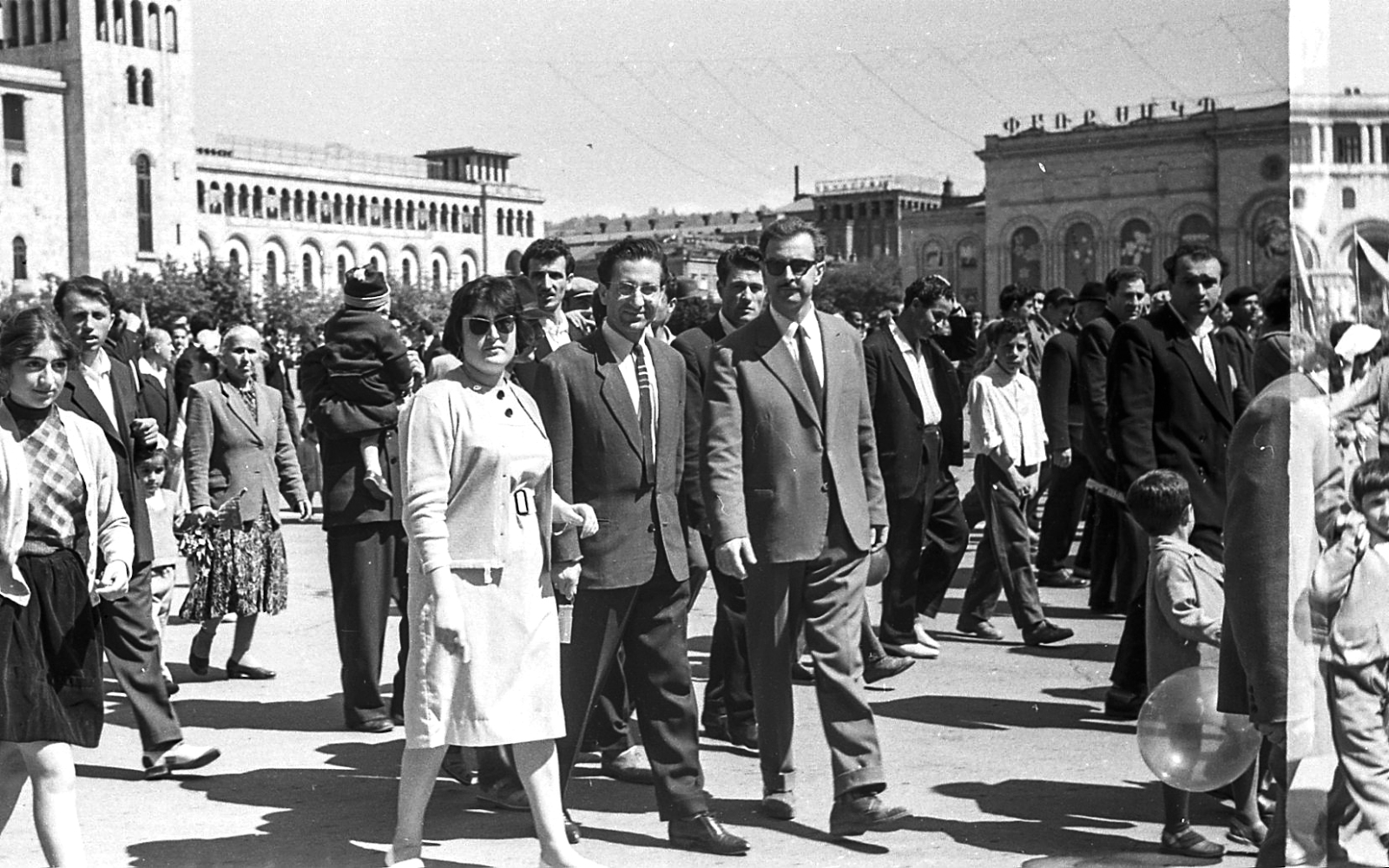
Radik Oganesovich Ananyan is one of the first employees of the Yerevan Scientific Research Institute of Mathematical Machines, which opened in 1956. In an interview with the DataArt museum project, he recalls how the new institute worked, how the first computers were created and how the short film "Short Circuit" was shot, which won first place at the Moscow Film Festival.
In the photo by Radik Ananyan, employees of the institute with colleagues at a demonstration on May 1, 1960. The film "Short Circuit" itself and another tape by Radik Oganesovich are below in the article.
Photographer and radio amateur
- I was born in 1934 in Yerevan. During his school years he became interested in radio amateurism. My school friend had a neighbor Sergei Shahazizyan. He then either studied at the institute, or already worked. Sergei explained to me how the radio tubes are arranged - then everything was done on them. We became friends with Sergei, probably, he liked me for my technical inclinations. Then he worked in the House of Radio and was the first to come up with a device that made it possible to avoid a click when the microphone was turned off. Nobody could get rid of this sound, but he did it. He is a very talented guy, he is no longer with us.
During my school years, I really wanted to build an amplifier to listen to music. Sergey suggested how, and I did. At that time it was great, especially since it had a 78-rpm electric motor for records - I bought it in Moscow. The result is an amplifier with a turntable. In the future, I was going to make a tape recorder. When I saw him for the first time through the window of an institution, I was shocked. Thanks to the magazine "Radio", I understood how it works. True, it never came to assembly.

Yerevan in the 1940s, Lenin Square, now Republic Square
- Did you go to the radio amateur circle?
- No. My amateur radio is purely amateur, it developed thanks to Sergei Shahazizyan. It was the end of the 1940s, the school did not even have the subject of "labor", it was then introduced.
- How did your family feel about your hobby?
- It's okay, I guess. I was always doing something, fixing something, building something.
- Where to go to study after school, there were no questions?
- I wanted to enroll in architecture, but did not pass in drawing. Since my school years, I have been engaged in photography. My first color photographs were taken in 1947, when paper and film had just appeared in Yerevan.

Radik Ananyan
- Was it a difficult process?
- Very complicated. To print one color photograph, one had to sit all night. I had to wait for my family to go to bed so that I could work in the dark. The water for developing should not have been warmer than 18 degrees ... With difficulty I mastered this business, but I did not do it all the time. Moreover, during his school years he did not earn anything, and it cost a lot of money. I collected a penny to buy one film.
Research Institute of Mathematical Machines
- What happened after you didn't enroll in architecture?
- He served in the army and went to work at the Institute of Physics as a radio operator. Then he moved to the Research Institute of Mathematical Machines. At the same time, he began to study in absentia at the MPEI, and from the 3rd year he transferred to the full-time department of the Yerevan Polytechnic Institute - to the Faculty of Cybernetics. Since I studied full-time, I had to work part-time. Then I organized an amateur film studio.
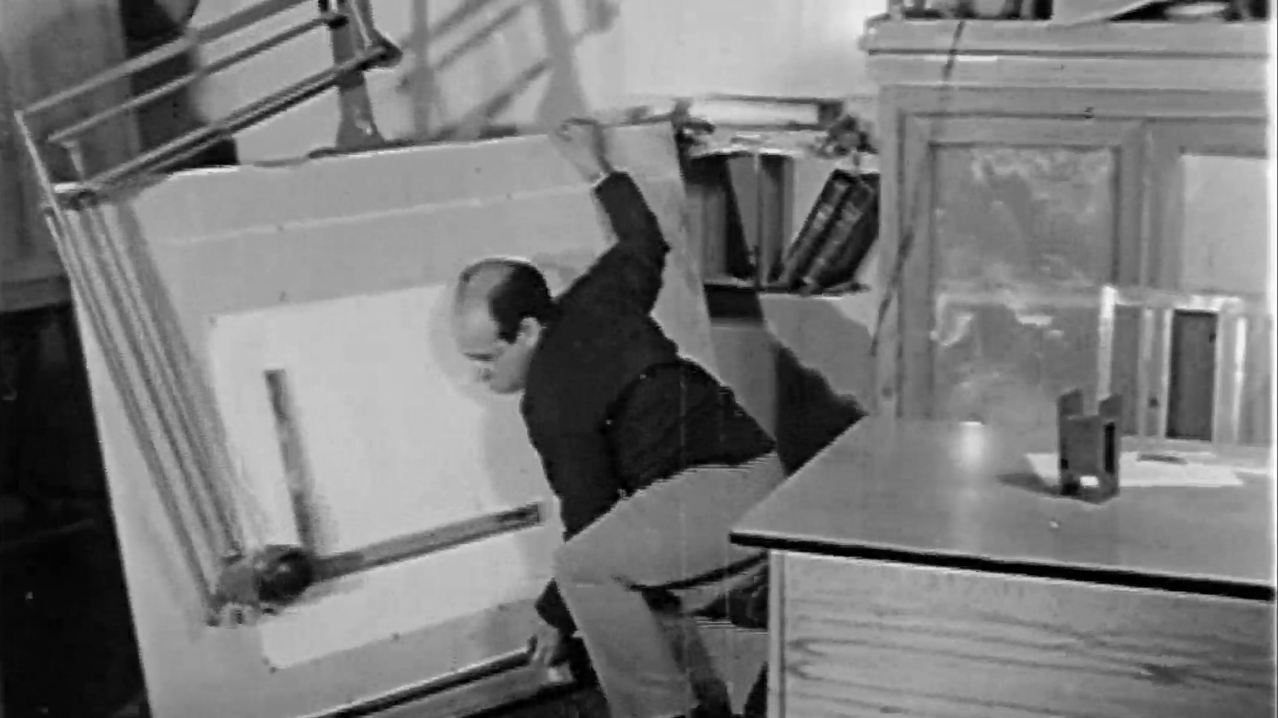
Still from the film "Short Circuit", dir. Radik Ananyan, Yerevan Research Institute of Mathematical Machines, 1967
- Having received your diploma, have you returned to your previous work at the Research Institute?
- I returned before graduation, in my last year. They called me because the long-term memory tape drives I was doing were already in production, they had to be handed over to the admissions committee. I was well acquainted with all the units of these devices, I was given a full salary and the right to come to work in my free time from school, with the condition to carry out tests on time and hand over finished products.
- When did you join the Research Institute of Mathematical Machines?
- In January 1957, one might say, during the organizational period, because YerNIIMM was formed in October 1956. Then it was a two-story building on the outskirts of the city. Wheat fields all around. Today it is already part of the city.
I learned about the new institute from the father of my school friend. Came for an interview with the chief engineer and was accepted as a technician. The first director of YerNIIMM (Yerevan Scientific Research Institute of Mathematical Machines) was Sergei Mergelyan, one of the youngest academicians of the Union. He did not manage the institute for long, because he was engaged in science. But they loved him very much, and in the future the institute was named after him.
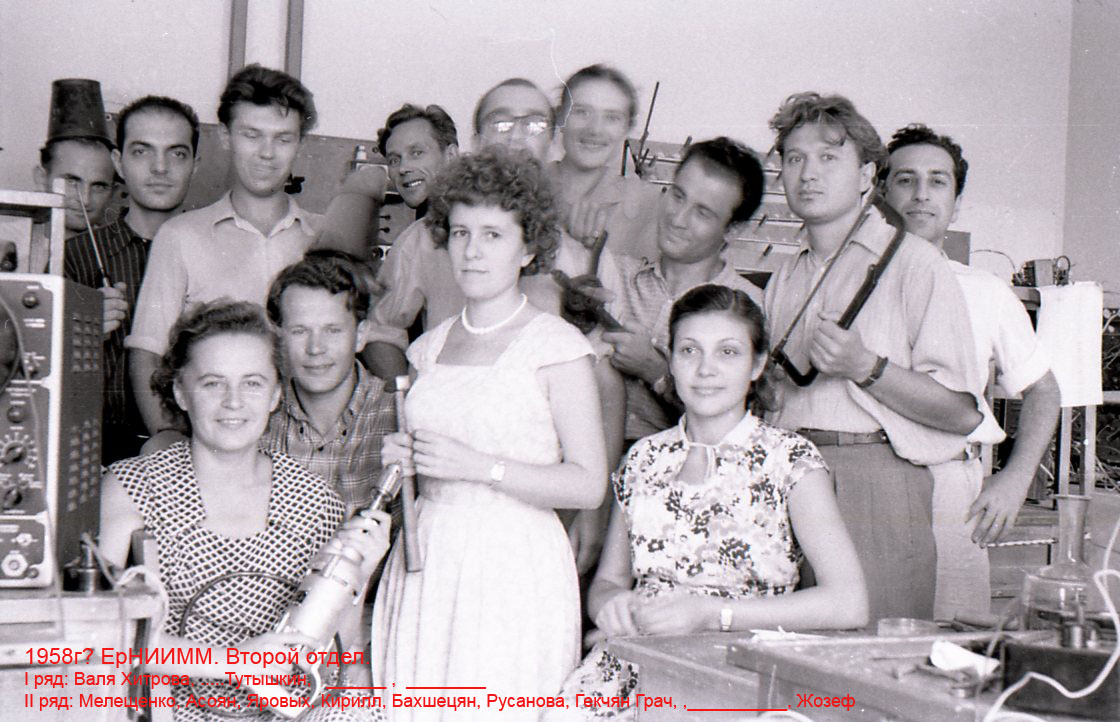
The development of the "Aragats" computer was carried out in the second department of YerNIIMM, 1958
Gradually the institute developed, new buildings and a residential area were built. A huge complex - there was both an institute and a factory. I became a leading engineer, the last year of work at the institute was engaged in a closed topic.
- Tell us about the first days of work at YerNIIMM.
- Most of the hired employees were immediately sent for training to different cities of the Union - Penza, Leningrad, Minsk. In Penza, for example, there was a computer equipment plant, if I am not mistaken, which produced the M-3 - one of the first machines in the USSR - we then copied it. Those who did not leave to gain experience read the book by the Japanese author Itshoki "Impulse Technique". What we would specifically do, then very few people understood. Then we got the first oscilloscope. Black, big. Later, small ones appeared, SI-1.
Each of us had a place at the laboratory table. Engineers and technicians themselves assembled power supplies for themselves for different voltages, which we received from our own generators.

Radik Ananyan's colleague Suren Hayrapetyan assembles a power supply unit. ErNIIMM, 1960
- When did you first see the computing machine?
- I didn't see the car until we made it ourselves. It was called "Aragats" in honor of our mountain. Big, she worked on radio tubes. Since the lamps were heating up, powerful ventilation was needed. Because of her, we all got sick many times.

Climbing Aragats, 08/01/1958 Second from the right - Radik Ananyan
- Was the machine architecture developed at your institute?
- Yes, although I had nothing to do with her, because I was engaged in entering information. This was done using film. After exposure and development, it became completely opaque and black. On it we knocked out holes with a special puncher. By the way, I developed and assembled this puncher for binary code on electromagnetic relays. The conclusion was made with a typewriter. Our institute had specialists in virtually all areas of computer technology, because we had to do everything ourselves. There was a power supply department for machines with all the necessary voltages. These lamps consumed an enormous amount of energy.
Our department dealt with external devices. A colossal achievement - a large cube on ferrite beads (each bit) that could store 4 kilobytes.

Magnetic tape drive (NML) for the first computers, ErNIMM, 1960.
Two types of magnetic media were used for memory — magnetic tapes and magnetic drums. In the future, magnetic disks from the Penza plant were used. The disks were stacked on top of each other in pieces of 10–20, depending on the configuration of the device, and the magnetic heads between them were read and written. When failures began, the disc was taken out and cleaned with alcohol. For this business, the posted employees all the time asked me for alcohol. I had two types - normal alcohol and technical alcohol. When the normal one is over, I say: "I won't give you a technical one - get poisoned." They: "If we were poisoned, half of the plant would be gone!" It turned out they drank it too.

Cell of the amplifier and shaper of the "Aragats" computer. ErNIIMM, 1958
- Do you remember how the first "Aragats" was launched?
- It gradually happened. A computer is not an airplane that must take off immediately. We made the same input by hand with toggle switches. Then the process was automated, and perforators and an input device were used. The hardest part about these machines is finding where the failure occurred. A thousand lamps, you need to figure out which one to replace.
- Were there standards for working hours without interruptions?
- Yes, we learned about them when the interdepartmental commission came to accept the work. "Aragats", by the way, was little exploited. But the fact that it was created was already great for that time. Then we also made the improved "Yerevan" computer. When it was handed over, work was already underway on a semiconductor machine. Diodes appeared, then transistors.
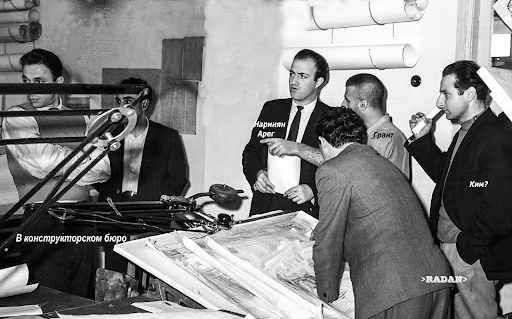
At the YerNIIMM design bureau, 1960s
- Are semiconductor machines also your own developments?
- Yes, absolutely. Then the integration started. Input is made by one city, output by another. If memory serves, of the peripheral devices we have in development only magnetic tapes.

Before testing the tape drive. Second from left - Radik Ananyan, Yerevan Research Institute of Mathematical Machines, 1960
ES EVM
- Your institute was also involved in ES computers. How it was? Was the coordination from Moscow?
- At that time, leading institutions were created in all sectors. NITSEVT was the head computer engineering for us. They were in charge of the entire household - where they would do what. Each institution in the Union developed its own system. Our institute was entrusted with the development of medium-sized machines: EC1030, EC1045.
- The EU was based on IBM. Have you had them?
- No, in the beginning we used exclusively books. When the book "IBM-360" was published in the USSR, it was immediately sold out in Armenia. In addition to our institute, other organizations began to appear that were engaged in computer technology and related industries. In the 90s, it all crashed.

Solemn meeting dedicated to the 10th anniversary of YerNIIMM, 1966
- What was the attitude towards the EU project in Armenia?
- We perceived him normally. We were so far behind that we needed some kind of prototype. It was impossible to go in this direction on your own without knowing what was happening in America. They have advanced technologies, we had to borrow them. It was not only in computing - in all industries. We have always had the motto “Catch up and overtake”. But the book we have released about IBM is incomplete. Some chapters have remained a secret to us. That is, it was impossible to make a car according to it - we had to think out ourselves. Therefore, the EU is not identical to IBM, processed in its own juice, so to speak. Our guys have made a lot of changes, of course, for the better. Whenever you undertake to do something, you try to make it better than the prototype.
- When you were developing, what language was the documentation in?
- In Russian. Throughout the Soviet Union, it was so that one could better understand each other. In academic institutions, especially in humanitarian subjects, national languages were already used.
Leisure and sports
- What was a typical working day at the institute?
- Each department has its own way. Someone had a good job, someone had such a job that you can't do it - all the same. Closer to the time of delivery of the product, the rush began. There was not enough time, and they sat in the evening and at night. After that we were given time off. You will rest for a week, then you start to get hot again.

Employees of YerNIIMM at a demonstration, November 7, 1959
- After the surrender, was there a holiday before the rest?
- Naturally. When they rented the car, they held a banquet in the restaurant for themselves and the commission. They collected money, they did not take from the invitees.
- What else was the joint vacation at the institute?
- We went to the mountains. It was organized either by the Komsomol committee, or by the trade union. They have always been engaged in the leisure of workers, helped in some matters. If you need a car, they allocated it. You need a tent - they bought it. At that time there was everything that was needed for such events.
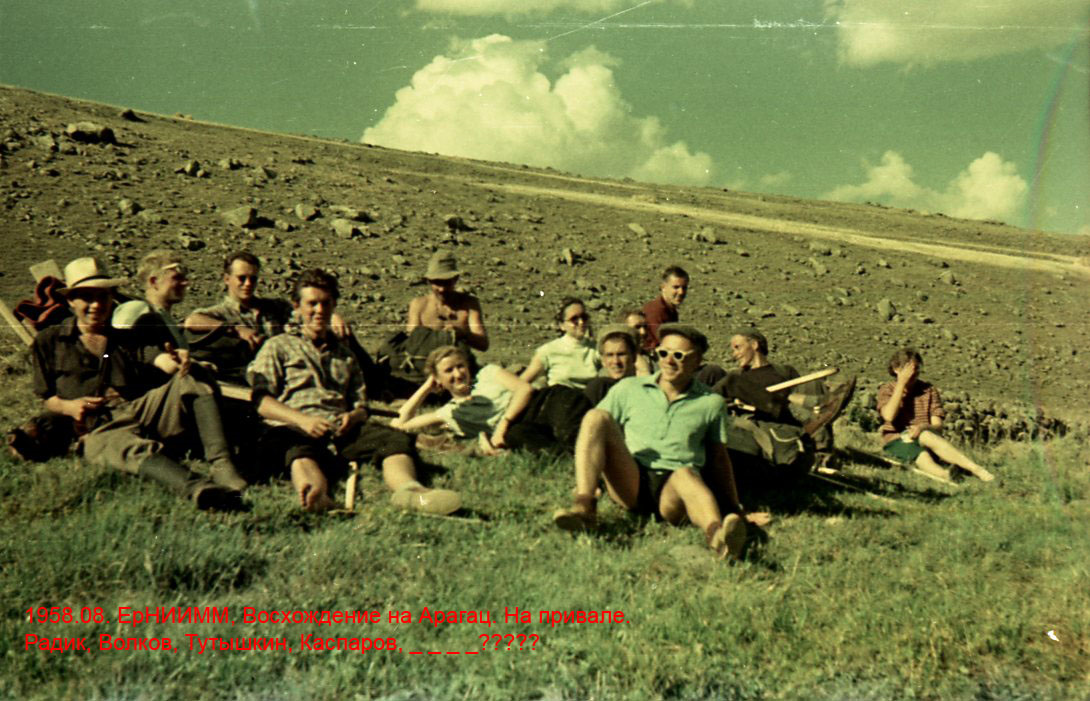
Climbing Mount Aragats, September 1958 Left - Radik Ananyan
We also had a radio circle - they learned Morse code, played "Fox Hunt". It's such an amateur radio sport. Everyone made an amplifier for themselves, which worked for a directional antenna. A fox is a transmitter hidden somewhere in the mountains and gives a signal after a certain interval of time. You are looking for him. At the start of the competition - 10-30 hunters, then they scatter in different directions, because each device shows its own. Whoever finds the "fox" first will win.

In the radio club YerNIIMM, 1960
Creation of a computing center
- Why did you leave YerNIIMM?
- In 1976, the Council of Ministers of Armenia needed an engineer familiar with computer technology. I was recommended there for the position of department head. At that time, a network of Computing Centers was being organized in the USSR. The head office is the Computing Center of the government of the Soviet Union, and computer centers were also opened in all republics, then in all ministries and various large departments.
At first I was the head of the information and communication center. Then he created a department with this item and became the head. This is how it worked until 1993.
- When you moved to a new place, the work was noticeably different?
- She was very different. At the institute we created something, but here we exploited it. The information and communication center is like a computing center. I called it "the final output devices of the machine." She herself was in Moscow.
- That is, you had a modem connection with a Moscow machine?
- Yes. That's why I said "like" a computing center. We made a real computing center later - I was instructed to create it. We bought a car, then, when computers appeared, we began to create networks. But that is another story.
- What happened after 1993?
- Disappointed with all the innovations after the collapse of the USSR, I applied and went abroad. From 2000 to 2004 he lived in St. Petersburg, then another 4 years - in Canada. I returned to Yerevan and don't want to leave anymore.

Unnecessary cell blocks, 1963
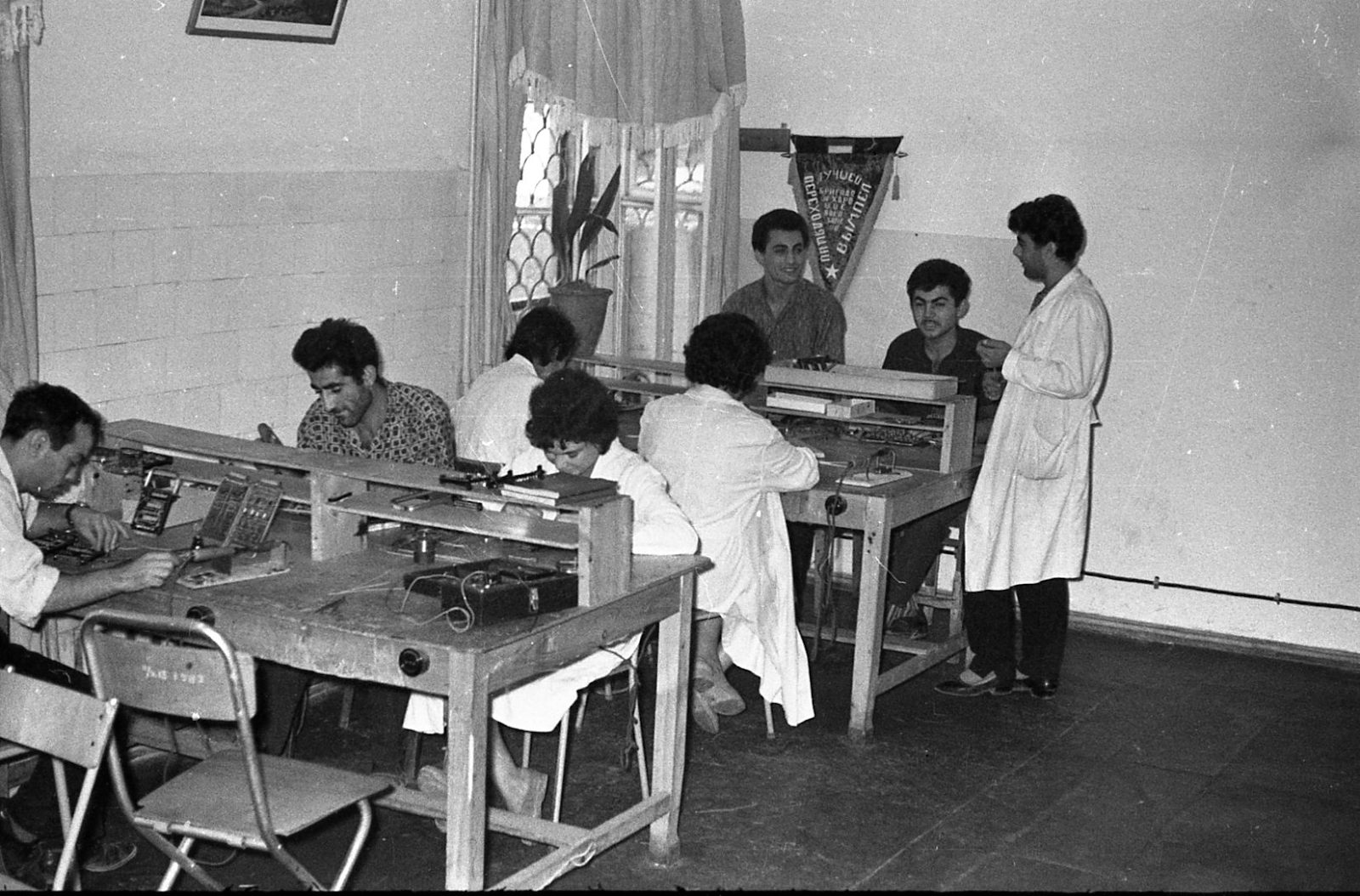
In the editing sector ErNIIMM, 1963
- When did you first get acquainted with a personal computer?
- I remember I bought my son BK. It has no screen, it had to be connected to a TV and a cassette recorder. The keyboard had its own, and nothing else. The son played when he was little. We got the first normal computers in 1988, when the earthquake happened. Then everyone helped us, and IBM sent 10 modern computers with a printer. They were distributed to large cities in the earthquake zone. Through them we received information on all work related to the restoration of the country.
I assembled my own computer when I lived in St. Petersburg, from what could be bought in stores. Then I bought a second-hand computer in Canada. Later "Toshibu" - already a laptop, new, normal. From that moment on, I always have laptops.
Short circuit and awards
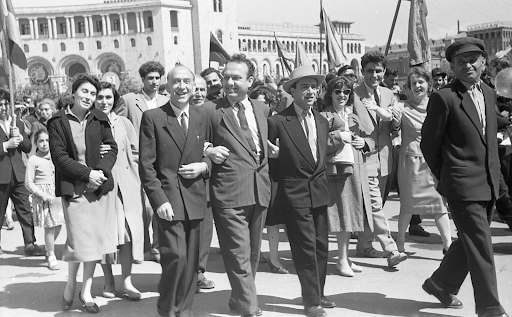
Demonstration with colleagues on May 1, 1962
- How did computer technology develop in Armenia during the Soviet era? Was there something of your own?
- Hard to say. At first, we knew nothing at all. Gradually, when they began to make machines, we could already keep up with all our science. They always tried to lower us a little, this is probably natural. But we already had good specialists. They appeared everywhere - Vilnius was engaged in this business, Minsk, Kiev ... I spent all the time on business trips. Sometimes he would entrust the trips to someone else so as not to go himself. Been wherever the industry has worked. First, we went to discuss issues of creation. When the product was delivered to the customer, we had to go to teach it to operate and repair.
- Have you ever been on business trips abroad?
- Me not. Once I went because of the cinema - in Czechoslovakia there was a festival of 16 mm films.
- Tell us about the film studio at the institute.
- I created it because I was very interested in cinema. At first there were three people in it, then a little more. Films were made by a small team. The artist you saw in Short Circuit was our lead designer. We made this film for the 10th anniversary of the institute, but it was not the first. One of our guys was in Japan and from there he brought an 8mm movie camera. On it we shot a film called “I, he, she”. Institute workers also played in it. The plot is as follows. A man in the lottery won a car, absolutely not understanding how to drive it. He writes an ad that he is looking for a driving instructor. Our designer seems to be unemployed and a bit of a swindler who seems to be able to do everything, but can not do anything. He says he will teach, although he himself does not know how to go. As a result, they have an accident.
The hero who wanted to learn was played by a guy who traveled to Japan. He had his own Volga. A second car was required. There were very few of them at the institute, only a few people. And now our chief engineer provided his old "Moskvich", he is now 102 years old. We made a scene of a collision - there was a reverse shot. Then, according to the script, the hero realizes that he is being deceived, runs after the swindler to beat him. It turned out that this scene could not be filmed on the street - the crowd had gathered. Nearby is the Fashion House, where they knew me - I once took pictures there. I went to them, asked to do a sort of fashion show. The swindler runs in there, takes off his jacket and walks along the catwalk, as if showing clothes himself.
I have not preserved this film - someone took it and did not give it back, but there were no copies. The word "digitization" did not exist then either. Then we were very happy when we saw a plot borrowed from our film in Beware of the Car.
Film "Short Circuit", dir. Radik Ananyan, 1967
- Did you receive any awards for "Short Circuit"?
- There was a society of filmmakers in Yerevan. When they found out that we had a 40-minute film, they asked to show it. Then we took 1st place at the republican competition, and the society sent our film to Moscow to the All-Union Amateur Film Festival in honor of the 50th anniversary of Soviet power. They had a time limit - no more than 20 minutes. I myself have already thought that it is necessary to reduce. Of course, it was interesting for us to look at ourselves, but this is not interesting for an outside viewer.
When I cut, there were a lot of dramatic moments - it's a pity to cut. But he even cut out an episode with the participation of the director of the research institute at 20:17 minutes. I was both a director and a leader. He showed himself, made a sound. As a result, we received a diploma for the first place among 16 mm films, and the designer Sarkisov - for the best role.
Apparently, thanks to the "Short Circuit" the next plenum of the USSR radio amateurs was held in Yerevan. Its members visited our studio. We received them in such a way that later in Moscow they talked about it with admiration. When we made sound for the film, we simultaneously recorded different jokes. Then they decided to make them on the subject of this plenum. Our designer Lenya welcomed the guests on behalf of people of different nationalities. With appropriate diction, accent. Now it would seem trivial, but then it was so funny and unexpected that everyone went to bed.
« ». 16- 1969 . - « » , . . «» «».